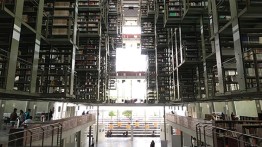Archlog
Sean Canty and Stephanie Lin Shortlisted for MoMA YAP
POSTED ON: November 17, 2016

Gallery of Figures
Congratulations to Visiting Professor Sean Canty and Instructor Stephanie Lin, two recent additions to the School of Architecture faculty, who have been selected as finalists for the MoMA Young Architects Program (YAP) for their collaborative work as Office of Three. The winning architect(s) will install a structure in PS1’s iconic courtyard during its summer 2017 for its Warm-Up music series.
A full list of this year’s finalists can be found here. Previous winners of the prize include BEATFUSE! by Pablo Castro and 1997 Cooper Union architecture graduate Jennifer Lee of OBRA Architects.
Tags: Lea Bertucci
Fourth Year Models on Display at Turnbull & Asser
POSTED ON: November 8, 2016

Photo by Mark Roskams
An array of architectural models from the Spring 2016 Design IV studio, led by Professor Diane Lewis, Professor Peter Schubert, Instructor Daniel Meridor, Visiting Assistant Professor Daniel Sherer and Visiting Lecturer Francois de Menil is now on display in an unlikely venue. The East 57th Street windows of upscale men’s clothing retailer, Turnbull & Asser, feature models by Aimilios Davantlis Lo, Jorge Flores, Sam Koopman, Kelsey Lee, Piao Liu, Hui Rong Liu, Hugh Scott Moncrieff, Stephanie Restrepo and Kyle Schroeder, channeling the lifestyle of the urban architect. Inspired by the display of fourth year design studio work in the ground floor windows of Cooper Union’s Foundation Building as part of the 2016 End of Year Show, Zander Scheider, Turnbull & Asser’s director of design, called on the talents of Cooper’s architecture students to enhance the architect-themed display. The installation will be on view until November 11th at 50 East 57th Street. Read More on Cooper Union’s website.
Tags: Lea Bertucci
Laurie Hawkinson Appointed to NYC Public Design Commission
POSTED ON: November 3, 2016

Wilce Student Health Center, OSU, view at entrance
Cooper Alum, Laurie Hawkinson (AR ’83) has just been appointed to the NYC Public Design Commission, New York City’s design review agency. In mayor Bill De Blasio’s announcement, he stated; “Laurie’s years of work designing projects for a wide range of clientele, both domestically and internationally, as well as both privately and publically, demonstrate her expertise in the field”. In this position, Ms. Hawkinson will oversee proposals for permanent works of architecture, landscape architecture and art on city-owned property as part of an 11-member council.
Since graduating from The Irwin S. Chanin School of Architecture of the Cooper Union, Hawkinson has received an MA in Department of Art Practice from UC-Berkeley, and a Bachelor of Fine Arts from UC-Berkeley. She is a partner at Smith-Miller + Hawkinson Architects (SMH+) and Professor of Architecture at Columbia University’s Graduate School of Architecture, Planning and Preservation, and currently serves on Columbia University’s Professional Schools’ Diversity Council.
Hawkinson joins two other Cooper Union architecture graduates with high profile civic posts. In August, 2016 Mayor de Blasio nominated Michael Samuelian (AR’95) as President and CEO of the Trust for Governors Island. In January, 2016, Gina Pollara (AR’91) was named President of the Municipal Art Society of New York.
Tags: Lea Bertucci
Mexico City Reflections
POSTED ON: October 10, 2016
With Professors Maria Gonzalez Pendas and Mersiha Veledar
For the past several decades the Third Year Design Studio has engaged in an architectural analysis project. These have been wonderfully creative exercises that undertook the question of how a design speculation relates to disciplinary precedents, seeking to understand and transform them towards creative work on the part of the student.
This semester, for the first time in the school's history, we were able to combine the analysis project with a travel visit to see a robust array of building projects first hand. The trip to Mexico City and surrounding areas allowed the students to witness the buildings they are analyzing in their phenomena of material, space and light, their programmatic activity, their urban relationship, and their cultural context. The precedents were no longer mediated drawings and photographs, but real things in the world, with all the associated discoveries and problems that everyday existence brings to architecture.
The trip also allowed the students to immerse themselves in the culture of Mexico City. In this aspect it was not only important to see these projects, but to connect with the larger situations that architecture always exists within and springs from. The site visits were complimented by meeting with distinguished local architects, by lectures and discussions, both formal and informal, where the backgrounds of a place began to leap into direct relation with the architecture under investigation.
It was an amazing opportunity and a rewarding experience that will influence not only the work done by the students this semester, but hopefully the work they continue to produce as architects in the world.
The trip to Mexico City was also covered in The Cooper Pioneer, a biweekly student newspaper for The Cooper Union for the Advancement of Science and Art. The article includes comments from students about their travel experiences.
Tags: Mersiha Veledar






